|
|
|

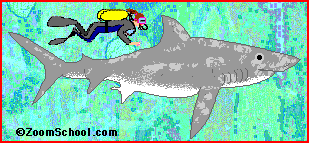 |
GREAT WHITE SHARK
Carcharodon carcharias |
GENERAL DESCRIPTION
The great white shark is a streamlined swimmer and a ferocious predator
with 3,000 teeth at any one time. This much-feared fish has a torpedo-shaped body, a pointed snout, a crescent-shaped tail,
5 gill slits, no fin spines, an anal fin, and 3 main fins: the dorsal fin (on its back) and 2 pectoral fins (on its sides).
When the shark is near the surface, the dorsal fin and part of the tail are visible above the water.
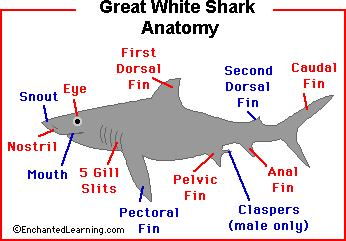 COLORATION COLORATIONOnly the underbelly of the great white shark is
actually white; its top surface is gray to blue gray. This is useful in hunting its prey. The great white usually strikes
from below and its grayish top coloration blends in with the dark water, enabling it to approach the prey unobserved.
SIZE
 Great whites average 12-16 feet long (3.7-4.9 m) long. The biggest great white shark on record was 23 feet (7 m) long, weighing
about 7,000 pounds (3200 kg). Females are larger than males, as with most sharks. Shark pups can be over 5 feet (1.5 m) long
at birth. Great whites average 12-16 feet long (3.7-4.9 m) long. The biggest great white shark on record was 23 feet (7 m) long, weighing
about 7,000 pounds (3200 kg). Females are larger than males, as with most sharks. Shark pups can be over 5 feet (1.5 m) long
at birth.
DIET AND FEEDING HABITS
Young great white sharks eat fish,
rays, and other sharks. Adults eat larger prey, including pinnipeds (sea lions and seals), small toothed whales (like belugas),
otters, and sea turtles. They also eat carrion (dead animals that they have found floating dead in the water).
Great
whites do not chew their food. Their teeth rip prey into mouth-sized pieces which are swallowed whole.
A big meal
can satisfy a great white for up to 2 months.
TEETH
 The great white shark has 3,000 teeth at any one time. They are triangular, serrated (saw-edged), razor-sharp, and up to 3
inches (7.5 cm) long. The great white shark has 3,000 teeth at any one time. They are triangular, serrated (saw-edged), razor-sharp, and up to 3
inches (7.5 cm) long.
The teeth are located in rows which rotate into use as needed. The first two rows are used in
obtaining prey, the other rows rotate into place as they are needed. As teeth are lost, broken, or worn down, they are replaced
by new teeth that rotate into place.
SENSES
Shark's primarily use their
sense of smell followed by their sensing of electric charges. The shark's other senses, like sensing changes in water pressure,
eyesight, and hearing, are less important.
The great white's nostrils can smell one drop of blood in 25 gallons (100
liters) of water. (Shark nostrils are only used for smell and not for breathing, like our nostrils. They breathe using gills,
not nostrils.)
The sensing of minute electrical discharges in the water is accomplished by a series of jelly-filled
canals in the head called the ampullae of Lorenzini. This allows the shark to sense the tiny electrical fields generated by
all animals, for example, from muscle contractions. It may also serve to detect magnetic fields which some sharks may use
in navigation.
The great white is the only type of shark that will go to the surface and poke its head up out of the
water. No one knows exactly why it does this; perhaps it is to see potential prey such as surface-dwelling sea lions.
GREAT WHITE SHARK ATTACKS
Most great white attacks are not fatal. Great whites account for
about 1/2 to 1/3 of all 100 annual reported shark attacks. Of these 30-50 great white attacks, only 10-15 people die.
SOCIAL GROUPS
Great whites are usually solitary animals but are occasionally spotted travelling
in pairs.
HABITAT
Great white sharks are found near shore along most of the temperate
(not very hot and not very cold) coastlines around the world.
DISTRIBUTION
Great
white sharks have been observed along the coastlines of California to Alaska, the east coast of the USA and most of the Gulf
coast, Hawaii, most of South America, South Africa, Australia (except the north coast), New Zealand, the Mediterranean Sea,
West Africa to Scandinavia, Japan, and the eastern coastline of China and southern Russia.
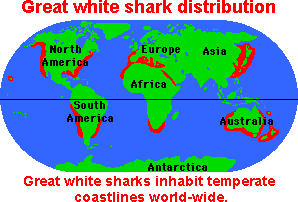 MIGRATION MIGRATIONIn the fall, some females migrate to warmer waters (for example,
southern California) to give birth. SWIMMINGGreat whites are propelled
through the water by their powerful tails. The fins are only used for balance. Their movement is more like an aircraft's flight
than other fishes swimming. They average about 2 mph (3.2 kph) but can swim 15 miles per hour (24 kph) in short bursts. They
swim constantly or they will sink since, like other sharks, they have no gas filled swim bladder to keep them afloat like
bony fish do. Like other sharks, their large, oily liver provides some buoyancy (floating ability). but they are still heavier
than water and will sink unless they are propelling themselves through the water. Also like other sharks, they cannot swim
backwards or even come to an abrupt stop, because their fins are not flexible like other fish. In order to go backwards, they
must stop swimming and fall backwards, using gravity to propel themselves backwards.
It has been recently discovered that great white sharks can jump out of the water. They jump into the air from deep water
in order to catch fast-swimming seals
REPRODUCTION
 Great white sharks reproduce via aplacental viviparity; they give birth to 2-14 fully-formed pups that are up to 5 feet (1.5 m) long. Like all sharks, fertilization of the eggs
occurs within the female. The eggs hatch within the female and are nourished by eating unfertilized eggs and smaller siblings
in the womb. There is no placenta to nourish the babies - they must fend for themselves, even before birth. They swim away
from the mother immediately after birth, there is no maternal care-giving. Great white sharks reproduce via aplacental viviparity; they give birth to 2-14 fully-formed pups that are up to 5 feet (1.5 m) long. Like all sharks, fertilization of the eggs
occurs within the female. The eggs hatch within the female and are nourished by eating unfertilized eggs and smaller siblings
in the womb. There is no placenta to nourish the babies - they must fend for themselves, even before birth. They swim away
from the mother immediately after birth, there is no maternal care-giving.
LIFE SPAN
No
one knows the life span of the great white shark. Some people estimate it to be about 100 years, but this has not been proven.
POPULATION COUNT
Great whites are decreasing in numbers and are rare due to years
of being hunted by man. They are a protected species along the coasts of California, USA, Australia, and South Africa.
GREAT WHITE SHARK CLASSIFICATION
Kingdom Animalia (animals)
Phylum Chordata
SubPhylum
Vertebrata (vertebrates)
Class Chondrichthyes (cartilaginous fish)
Subclass
Elasmobranchii (sharks and rays)
Order Lamniformes
Family Lamnidae
Genus Carcharodon
Species
C. carcharias |
 | GREAT WHITE SHARK ACTIVITIESA coloring/information print-out about the great white shark.
A simple coloring print-out about the great white shark.
A first grade shark addition activity. Solve the 1-digit addition problems, then do letter substitutions to answer a shark question.
GREAT WHITE SHARK LINKS
A page about the great white shark at UCMP Berkeley.
GREAT WHITE SHARK BOOKS
The Great White Shark by Richard Ellis &
John McCosker, 1991, Harper Collins, New York.
Cousteau's Great White Shark by Jean-Michel Cousteau, 1992, H. N.
Abrams, New York.
|
Information Sheets About Sharks (and Rays) |
Just click on an animal's name to go to that information sheet. If the shark (or ray) you're interested in isn't here,
check the Shark Dictionary.
|
 |
|
Many paleontologists are very interested in living groups, because the study of the living organisms can both unlock their
evolutionary history and provide important keys towards interpreting their fossil record. Some living groups have ancient
histories. For example, sharks have existed as a group for over 350 million years! Today, sharks and rays (elasmobranchs)
are represented by over 600 species that show a remarkable range of ecological and morphological diversity. Unlike the true
fishes, sharks do not have internal bone, but instead have a cartilaginous skeleton. Although many people are told that sharks
are primitive in comparison to other groups, this is not true. Many sharks are efficient and specialized hunters that have
thrived for millions of years.
This small exhibit shows an amazing predator: the great white shark (Carcharodon carcharias). The white shark
is found in temperate waters throughout the world's oceans, and it is an important, though not common, predator in California`s
coastal habitats. Scientists from several organizations throughout California including the Point Reyes Bird Observatory,
the Marine Mammal Center, the California Academy of Sciences, Bodega Bay Marine Laboratory, California Department of Fish and Game, and the Museum of Vertebrate Zoology at U.C. Berkeley, have been studying white sharks and their prey for several years in hopes to better understand their behavior
and ecology.
Food and Feeding Behavior
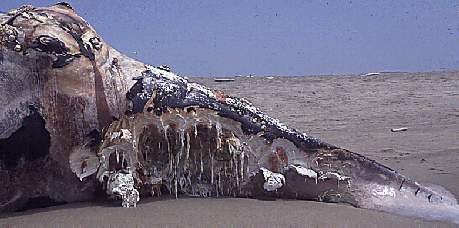
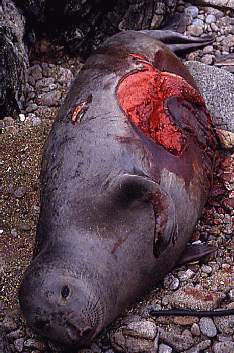
White sharks are predatory animals that begin life by feeding on fish, rays, and other sharks, and as they grow, switch
to feeding on marine mammals and scavenging on large animal carcasses. Their first mammalian prey are usually the small harbor
seal, but as the sharks increase in size, they become large enough to eat sea lions, elephant seals, and small toothed whales.
Attack strategy consists of a swift, surprise attack from below, inflicting a large, potentially fatal bite. The pinniped
often dies from massive trauma or blood loss, but the bites may be superficial or misplaced on the body, allowing the seal
to escape and survive the attacks with their scars as witness. Large white sharks will also scavenge on the carcasses of whale
sharks, and on the fat-rich blubber layer of dead whales. They will occasionally feed on sea turtles and sea otters, and are
known to attack, but not eat, humans.
Habitat and Distribution
 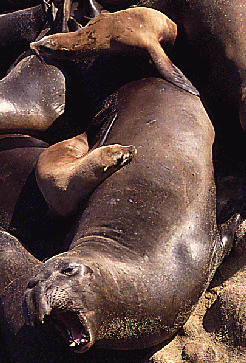 The waters off central California offer a rich bounty of food for white sharks, and every summer and fall they actively feed
in nearshore areas. The Farallon Islands, a national wildlife refuge about 27 miles off San Francisco, is a common feeding
ground for the sharks. Four species of pinnipeds, the northern elephant seal, the California sea lion, the Steller sea lion,
and the harbor seal, live around and breed on these islands, making a plentiful food resource for the white sharks. The coastal
waters along central California, especially around the Ano Nuevo State Reserve and along the Marin Headlands, is another common
feeding area for the sharks. In the summer the sharks feed on seals and sea lions along the coast as far north as Oregon and
occasionally the Gulf of Alaska, and in the Fall, they turn south and feed along the offshore islands. It is believed that
female white sharks migrate to southern California to give live birth to their offspring. In abnormally warm-water (El Niņo)
years, white sharks are more plentiful off central California because both they, and their prey, are shifted north. 1984-84
and 1991-92 show high trends in white shark predatory activity, and were the warmest oceanic seasons in recent history. The waters off central California offer a rich bounty of food for white sharks, and every summer and fall they actively feed
in nearshore areas. The Farallon Islands, a national wildlife refuge about 27 miles off San Francisco, is a common feeding
ground for the sharks. Four species of pinnipeds, the northern elephant seal, the California sea lion, the Steller sea lion,
and the harbor seal, live around and breed on these islands, making a plentiful food resource for the white sharks. The coastal
waters along central California, especially around the Ano Nuevo State Reserve and along the Marin Headlands, is another common
feeding area for the sharks. In the summer the sharks feed on seals and sea lions along the coast as far north as Oregon and
occasionally the Gulf of Alaska, and in the Fall, they turn south and feed along the offshore islands. It is believed that
female white sharks migrate to southern California to give live birth to their offspring. In abnormally warm-water (El Niņo)
years, white sharks are more plentiful off central California because both they, and their prey, are shifted north. 1984-84
and 1991-92 show high trends in white shark predatory activity, and were the warmest oceanic seasons in recent history.
Sharks and Media
    
    
Media sensationalism and widespread ignorance has given the white shark a bad rap. Although the species is responsible
for an average of 2-3 non-fatal attacks on swimmers, surfers, and divers each year, its role as a menace is exaggerated; more
people are killed in the U.S. each year by dogs than have been killed by white sharks in the last 100 years. Additionally,
scientific studies show that population of white sharks is low, with perhaps fewer than 100 adult animals in the state`s waters.
White sharks are important predators in the marine ecosystems of the California coast, and the people of California recognize
that. In 1992, the white shark was placed on the protected species list for the state of California, and is legally protected
from unlawful killing or exploitation. The original bill was supported by both scientists and fishing organizations, surfing
clubs and diving groups, private citizens and an array of government organizations. With your support and respect, we can
continue to live with this complex and misunderstood animal.
Studying the white shark requires the use of media equipment. The 14 or so images that are located below are the end result
of a pilot project run at the University of California Museum of Paleontology, the Department of Integrative Biology, and the Point Reyes Bird Observatory. Dr. Douglas Long has been doing research on
the ecological interactions, in particular the feeding habits and predatory behavior of great white sharks on marine mammals
along the coast of central California for several years now. His research has included autopsying dead marine mammals, studying
the feeding behavior of sharks, and trying to estimate shark population size. These images are directly related to the latter
two aspects of his research. From a post on the Farallon Islands, researchers watch the waters for injured marine mammals
and signs of sharks feeding. When they spot a feeding shark, they travel in a small boat to the site, and when the shark comes close they stick a small hand-held waterproof video recorder
under the water and film the shark as it passes by . The sharks are identified by characteristic marks like scars and skin blemishes. Most of the pictures at the end of this exhibit were taken with the express intent of looking for these
scars, so they may not be the most aesthetic images possible. However, they are the most useful. The ability to visually identify
sharks allows researchers to tell more about migration, ranges, and the number of individual sharks in the area. Douglas believes
that there are a suprisingly small number of individual sharks off the California coast, and that they have larger ranges
than previously thought.
Douglas Long , a graduate of the Department of Integrative Biology now at the California Academy of Sciences and the Department of Biology
at St. Mary's College in Moraga, has graciously made these images available. PLEASE DO NOT REPRODUCE WITHOUT PERMISSION FROM
THE PHOTOGRAPHER.
|
 |
|
|
 |
|
|
 |
|
|
 |
 |
|
|
|